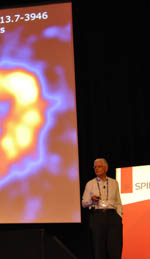Montréal is the 2014 host city for biennial event showcasing the newest advances for astronmical instrumentation
 |
| Daily plenary talks will be a returning highlight at this year's event; above, in 2012, Werner Hofmann, Max-Planck-Institut für Kernphysik, highlighted research in gamma ray detection at the High-Energy Stereoscopic System (HESS) project in Namibia. |
BELLINGHAM, Washington -- Reports on newly deployed and next-generation technology to explore the depth, breadth, and deep past of the universe will be presented at SPIE Astronomical Telescopes + Instrumentation 2014 later this month in Montréal. The biennial symposium and two-day exhibition will be held 22-27 June at the Palais des congrès de Montréal, and is sponsored by SPIE, the international society for optics and photonics.
The 12 conferences are organized into two program tracks - on technology advances, and telescopes and systems - and include more than 2,200 presentations in areas such as adaptive-optics systems, observatory operations, ground-based and airborne instrumentation, facility concepts, and cyber infrastructure.
The meeting's eight plenary talks by research leaders of innovative and ambitious missions will focus attention on the behind-the-scenes processes that define the path from the drawing board to the sky.
Onsite courses taught by international experts will cover systems engineering, advanced composite materials, aerial spectrograph design and development, optics analysis, and related topics at introductory and intermediate levels.
Nearly 100 companies -- including CILAS, PI (Physik Instrumente), SCHOTT, Thorlabs, and ZYGO -- will display products and technologies during the two-day exhibition, 25-26 June. Exhibition access is free.
The event's first Software Hack Day, organized by Sarah Kendrew of the University of Oxford, will be held in conjunction with the conference on Software and Cyberinfrastructure for Astronomy. The event is open to all attendees.
Symposium chairs are Gillian Wright, UK Astronomy Technology Center, and Luc Simard, National Research Council of Canada.
SPIE is the international society for optics and photonics, a not-for-profit organization founded in 1955 to advance light-based technologies. The Society serves nearly 256,000 constituents from approximately 155 countries, offering conferences, continuing education, books, journals, and a digital library in support of interdisciplinary information exchange, professional networking, and patent precedent. SPIE provided more than $3.2 million in support of education and outreach programs in 2013.
###
Contact:
Amy Nelson
Public Relations Manager
amy@spie.org
+1 360 685 5478
@SPIEtweets